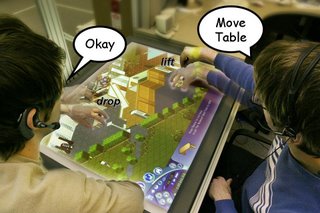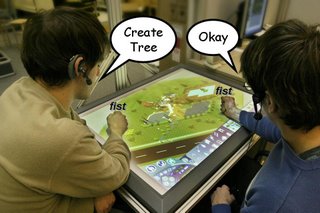

[ Pavel ] How would Diamond Touch enhance someone's enjoyment of a game like Warcraft III?
[ Ed ] In traditional console games (e.g., XBox, Playstation) you are forced to look away from other people to face a television set. People's hands are tied to the controller thus producing very little awareness information. Diamond Touch is a table top interactive surface that allows multiple people to play in a face to face setting. Thus people can see the game and the other people around the table. They can observe the rich hand gestures of others over the digital surface and they can hear the verbal utterances made through speech commands. The rich hand gestures provided by the Diamond Touch provide an engaging feeling normally only provided by manipulating physical objects such as a gun in an arcade. In one example, we show two people using whole hands to pick up a digital table in The Sims and in another we show a tree stamping gesture using a fist. These interactions make Diamond Touch a viable technology for repurposable home gaming.
[ Pavel ] Despite gaming's interactive nature, do you think that games could still be far more immersive, and do peripheral devices allow the opportunity for this?
[ Ed ] I don't consider playing a console game over a television with a game controller immersive. Arcades have done a lot to make gaming more imersive but they require expensive specialized hardware that would simply not be practical to have in a home setting. Peripheral devices such as flight joysticks and racing wheels are expensive and only work with a limited number of games. Also, since game designers cannot expect everyone to purchase and use these specialized peripheral devices, game interaction is still predominantly designed for the game pad. Hopefully digital tables will help to bridge the gap between home console and arcade games as they support rich hand gestures in a repurposable way.

